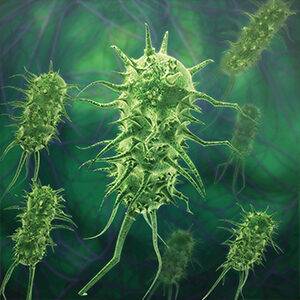What is fifth disease?
Fifth disease, also known as erythema infectiosum or “slapped-cheek” disease is a mild rash illness caused by human parvovirus B19.
Who gets fifth disease?
It occurs mostly in children during the winter and spring months, although anyone can be infected at any time of the year.
This virus infects only humans. Pet dogs or cats may be immunized against "parvovirus," but these are animal parvoviruses that do not infect humans. Therefore, a child cannot “catch” parvovirus from a pet dog or cat, and a pet cat or dog cannot catch human parvovirus B19 from an ill child.
How is fifth disease spread?
Fifth disease has been found in the respiratory secretions (e.g., saliva, sputum, or nasal mucus) of infected persons before the onset of rash, when they appear to “just have a cold.” The virus is probably spread from person to person by direct contact with those secretions, and indirectly by things
such as sharing drinking cups or utensils. In a household, up to 50% of susceptible persons exposed to a family member who has fifth disease may become infected. During school outbreaks, 10% to 60% of students may get fifth disease.
What are the symptoms of fifth disease?
Signs and symptoms of fifth disease are generally mild. An infected person may initially have a low-grade fever, headache, and fatigue. These symptoms can last up to a week and may disappear before the “slapped-cheek” rash appears on the face. Some people may get a second rash a few days later on their abdomen, back, buttocks, arms, and legs, where it appears as slightly raised red bumps, which makes the rash look lacy. The rash may be itchy and will typically resolve within one to three weeks. Once the rash appears, the person is no longer infectious and cannot spread the virus.
In addition to the typical rash, an infected adult may also develop joint pain and/or swelling. The joints in the hands, feet, and knees are most commonly affected. The pain and swelling in the joints typically resolves in a week or two, but can last for several months.
A pregnant woman who is exposed to someone with fifth disease usually has only a mild illness, even if not immune, and the unborn baby usually does not have any problems. There is a less than 5% chance of the unborn baby developing severe anemia or the woman having a miscarriage due to infection with parvovirus B19. A physician may want to perform a blood test to determine whether a pregnant woman has been previously exposed to fifth disease and is thus immune due to previous infection.
How soon after an infection do the symptoms appear?
A susceptible person usually becomes ill 4 to 14 days after being exposed to the virus, but for some, illness can take as long as 20 days to occur after their exposure. About 20% of adults and children who are infected with parvovirus B19 do not develop any symptoms.
When and for how long is a person able to spread fifth disease?
A person with fifth disease can transmit the virus just before they develop symptoms until the onset of their rash. People without symptoms can also transmit the virus.
Does the infection of fifth disease make a person immune?
Persons infected with the virus develop lasting immunity that protects them against future infection. About 50% of adults in the United States have been previously infected with parvovirus B19 and are thus immune to it.
What are the complications associated with fifth disease?
Fifth disease is usually a mild illness that resolves on its own among children and adults who are otherwise healthy. Joint pain and swelling in adults can occur but usually resolves in weeks to months without long-term disability.
Parvovirus B19 infection may cause serious illness in persons with sickle-cell disease or similar types of chronic anemia. In such persons, parvovirus B19 can cause an acute, severe anemia. The ill person may be pale, weak, and tired, and should see his or her physician for evaluation. (The typical rash of fifth disease is rarely seen in these persons.) Once the infection is controlled, the anemia resolves.
Furthermore, persons who have weakened immune systems may also develop a chronic anemia with parvovirus B19 infection that may require medical evaluation and treatment. People who have leukemia or cancer, who are born with immune deficiencies, who have received an organ transplant, or who have human immunodeficiency virus (HIV) infection, are at risk for serious illness due to parvovirus B19 infection.
Occasionally, serious complications may develop from parvovirus B19 infection during pregnancy. For questions on this contact your obstetrician.
Are there vaccines for fifth disease?
There is no vaccine or medication that can prevent parvovirus B19 infection after an exposure.
What can be done to prevent the spread of disease?
Frequent hand washing is recommended as a practical and effective method to decrease the chance of becoming infected. Excluding persons with fifth disease from work, child care centers, or schools is not likely to prevent the spread of the virus, since people are contagious before they develop the characteristic rash.

Communicable Disease Investigation & Prevention (CDIP)
Epidemiologists monitor, track, and respond to infectious disease in the community to prevent spread of illness.

